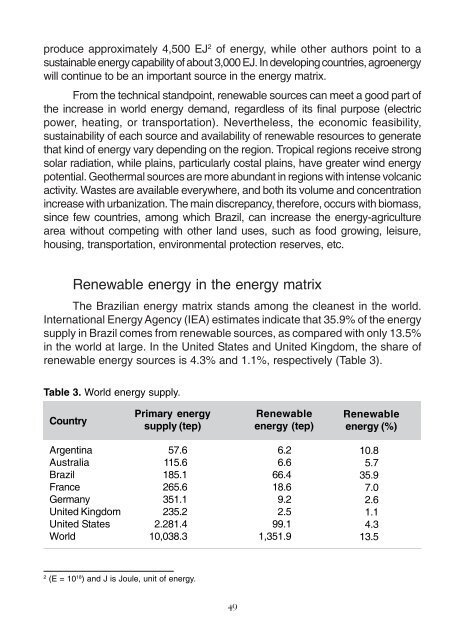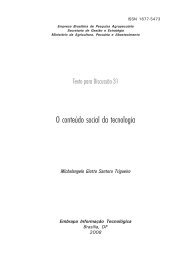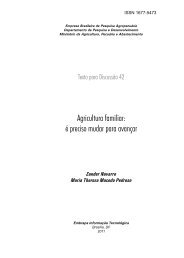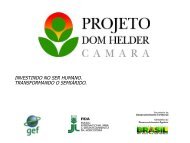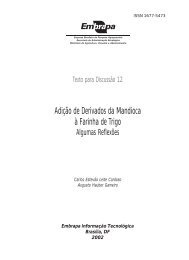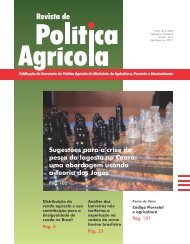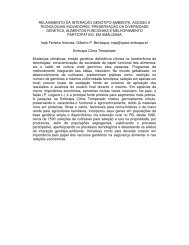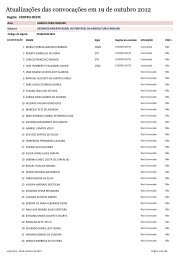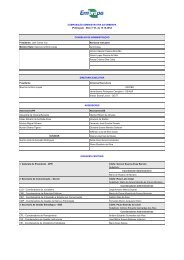Ministry of Agriculture, Livestock and Food Supply - Embrapa
Ministry of Agriculture, Livestock and Food Supply - Embrapa
Ministry of Agriculture, Livestock and Food Supply - Embrapa
Create successful ePaper yourself
Turn your PDF publications into a flip-book with our unique Google optimized e-Paper software.
produce approximately 4,500 EJ2 <strong>of</strong> energy, while other authors point to a<br />
sustainable energy capability <strong>of</strong> about 3,000 EJ. In developing countries, agroenergy<br />
will continue to be an important source in the energy matrix.<br />
From the technical st<strong>and</strong>point, renewable sources can meet a good part <strong>of</strong><br />
the increase in world energy dem<strong>and</strong>, regardless <strong>of</strong> its final purpose (electric<br />
power, heating, or transportation). Nevertheless, the economic feasibility,<br />
sustainability <strong>of</strong> each source <strong>and</strong> availability <strong>of</strong> renewable resources to generate<br />
that kind <strong>of</strong> energy vary depending on the region. Tropical regions receive strong<br />
solar radiation, while plains, particularly costal plains, have greater wind energy<br />
potential. Geothermal sources are more abundant in regions with intense volcanic<br />
activity. Wastes are available everywhere, <strong>and</strong> both its volume <strong>and</strong> concentration<br />
increase with urbanization. The main discrepancy, therefore, occurs with biomass,<br />
since few countries, among which Brazil, can increase the energy-agriculture<br />
area without competing with other l<strong>and</strong> uses, such as food growing, leisure,<br />
housing, transportation, environmental protection reserves, etc.<br />
Renewable energy in the energy matrix<br />
The Brazilian energy matrix st<strong>and</strong>s among the cleanest in the world.<br />
International Energy Agency (IEA) estimates indicate that 35.9% <strong>of</strong> the energy<br />
supply in Brazil comes from renewable sources, as compared with only 13.5%<br />
in the world at large. In the United States <strong>and</strong> United Kingdom, the share <strong>of</strong><br />
renewable energy sources is 4.3% <strong>and</strong> 1.1%, respectively (Table 3).<br />
Table 3. World energy supply.<br />
Country<br />
Argentina<br />
Australia<br />
Brazil<br />
France<br />
Germany<br />
United Kingdom<br />
United States<br />
World<br />
Primary energy<br />
supply (tep)<br />
57.6<br />
115.6<br />
185.1<br />
265.6<br />
351.1<br />
235.2<br />
2.281.4<br />
10,038.3<br />
2 (E = 10 18 ) <strong>and</strong> J is Joule, unit <strong>of</strong> energy.<br />
49<br />
Renewable<br />
energy (tep)<br />
6.2<br />
6.6<br />
66.4<br />
18.6<br />
9.2<br />
2.5<br />
99.1<br />
1,351.9<br />
Renewable<br />
energy (%)<br />
10.8<br />
5.7<br />
35.9<br />
7.0<br />
2.6<br />
1.1<br />
4.3<br />
13.5


